Reviews
On Samos, Greece, a Show Takes an Intimate Look at the Refugee Crisis
Can art help to convey the bigger context of the crisis?
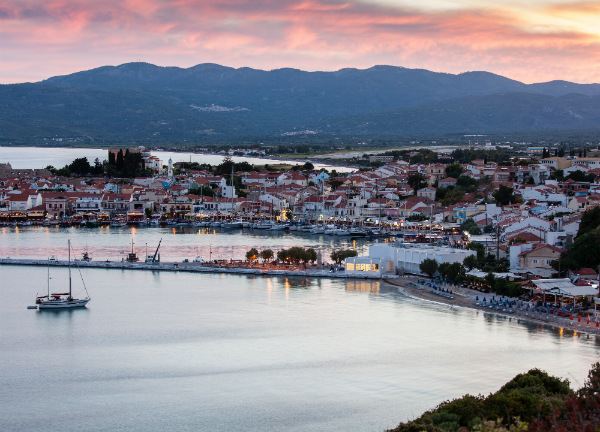
Can art help to convey the bigger context of the crisis?

Hili Perlson

“I can’t imagine doing an exhibition about anything other than the refugee crisis,” curator Katerina Gregos told a handful of journalists invited by the Schwarz Foundation to visit the group show “A World Not Ours” at the foundation’s Art Space Pythagorion, on the island of Samos.
Separated from Turkey by less than 2 kilometres of sea, Samos, like other Greek islands in the north Aegean, has been an entry point into Europe for thousands of migrants and asylum seekers who survived a perilous journey at sea. Since March, when Europe signed an agreement with Turkey to take back migrants from Greece in exchange to the EU’s resettlement of Syrian refugees residing in Turkey and other forms of financial support, the number of new arrivals on the island’s shores has decreased dramatically, with thousands now risking the journey to Europe from Libya instead. The registration centers on the islands of Lesbos, Chios, Leros, and Samos have been turned into detention camps. Currently, there are about 1,000 migrants and asylum seekers detained in Samos.
Gregos, who was invited by the Schwarz Foundation’s director Chiona Xanthopoulou-Schwarz to curate the space’s fifth summer exhibition, was faced with a challenging task to say the least. There have been numerous recent attempts in artworks, exhibitions, and actions to raise awareness of the refugee crisis, many of which have failed to transcend the realm of visual platitude in approaching the connections between content, form, representation, and activism.
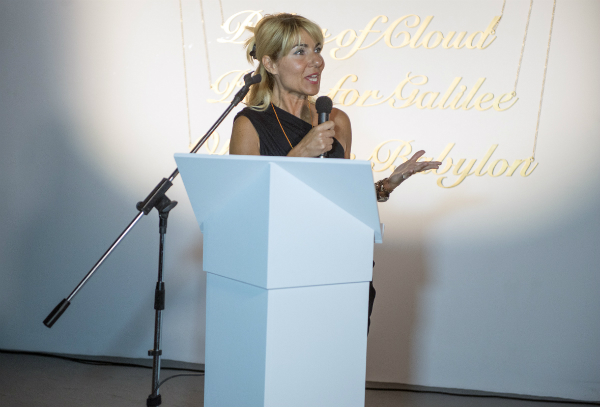
Katerina Gregos speaking at the opening night. Courtesy of Schwarz Foundation. Photo ©Panos Kokkinias
Gregos sought to avoid these pitfalls by addressing the issue as an international and age-old crisis, neither place- nor time-specific. Opting for a broader perspective was a thoughtful and ultimately successful approach, as many of the works on view—mostly by under-the-radar artists—would not have been as impactful on their own. That said, Gregos’s repeated assertion that the exhibition was created not for the international art world, but rather for the inhabitants of Samos and those intimately familiar with the state of the refugee crisis felt at times like a safety net against criticism—especially when told to a group of international journalists.
With the show opening at the height of tourist season, Samos was only at half its capacity, and there was no question about the toll on the island’s economy. The Schwarz Foundation, a German-Greek private initiative—whose founders are, importantly, not art collectors—runs an annual music festival as well, which opens a few days after the art opening. It’s thus clear that the majority of the visitors to the exhibition will be Samos residents, and a more tactful explanation Gregos offered about the selection of the works was her attempt to balance the global and the local. A video work by filmmaker Marina Gioti, Saint Marina, (2016)—which centers, through a personal family story, on the expulsion of over a million Christian Greeks from Asia Minor in the Greek-Turkish war of 1919-1922—will strike a chord with many in Samos, whose grandparents were displaced from there.
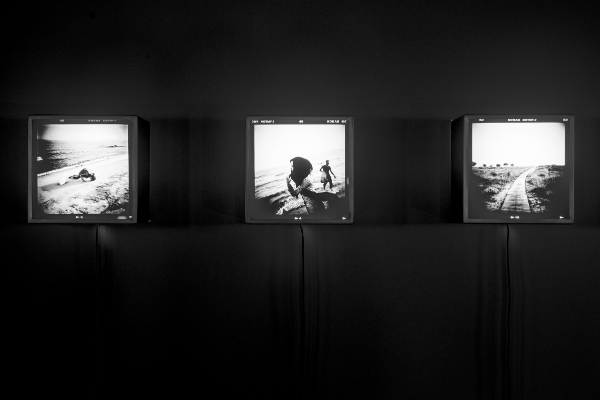
Giorgos Moutafis, Europa Europa, (2016). Courtesy of the Schwarz Foundation. Photo ©Panos Kokkinias
Two rooms in the space were dedicated to two different photojournalists tackling the conundrum of media representation of the crisis: one by Pulitzer-prize winner Yannis Behrakis, and the other by Giorgos Moutafis. According to Moutafis, whose black-and-white photos are presented on light boxes in a darkened room, he began photographing refugees arriving in Greece after encountering men whose features he couldn’t place and learned they came from Afghanistan. His very first photo of new arrivers on the Greek shores ended up in Time magazine. Since then, he has continued his focus and will soon be traveling to Libya to document the conditions of refugees there. He told me that the people of Samos have been exemplary in helping those arriving, with many volunteering around the camp, dubbed the “hotspot.”
To emphasize their stylistic distinction, Behrakis’s photographs are projected as a slideshow on a large screen, while newspaper clippings and printed-out web pages featuring his photographs are presented in a glass case, showing the headlines and news reports his work is used to illustrate. In this room, an audio of interviews with two asylum seekers plays in a loop: one told by a Syrian mother of three, and one by a Pakistani migrant. “We didn’t choose this war,” the Syrian single mother says. These interviews were recorded by American activist Sallie Latch, an octogenarian artist and teacher who came to volunteer in Samos back in March, just as the EU agreement with Turkey came into effect. She now teaches children who live in a separate building outside the camp dedicated to families with young babies or pregnant women.
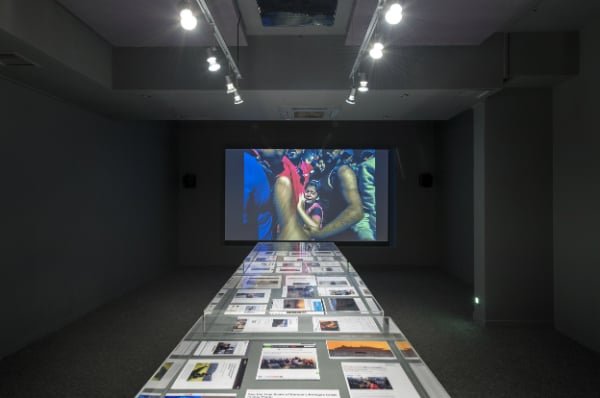
Yannis Behrakis, The Persecuted (Kos, Lesbos, Idomeni, Piraeus, 2015). Courtesy Schwarz Foundation, photo ©Panos Kokkinias.
Latch’s recordings, which also appear as transcriptions on a small screen, were a last-minute addition to the show, as Gregos became aware of her work through another artist in the show who volunteers at the hotspot. However, it is hard to imagine the show without these; the recordings are important documentations of this crisis, giving a voice to the refugees and, as Latch pointed out, she was baffled to find out that no one else was doing that. The media representation of the crisis through snapshots of the human drama leaves out much of the context, and in turn, paradoxically, the humanity of the individuals arriving to Europe.
Austrian artist and activist Tanja Boukal has several works in the show from recent trips to points of entry into “Fortress Europe.” Two new works, produced for the show with support from the Schwarz Foundation, look at the industry around human smuggling. In Izmir Concrete (2016), the artist printed on concrete photographs taken around the Turkish city of Izmir, from whose shores many leave by boat at night towards Greece. The concrete bricks are arranged as a wall with shots of stores displaying life vests alongside tourist souvenirs, rubber boats, and families sitting around and waiting, with all their belongings packed in black plastic bags. Opposite it, the wall-mounted piece Memories of Travels and Dreams (2016), shows advertisements for a day trip on a ferry from Izmir to Samos, with special family prices for an average €30 per person. The price human traffickers charge per head can be about €3,000.
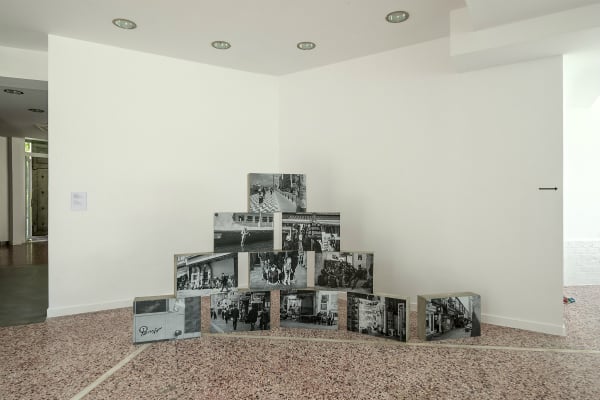
Tanja Boukal, Izmir Concrete (2016). Courtesy of Schwarz Foundation, photo ©Panos Kokkinias.
Another work produced for the show is Adobe House (Samos) (2016), by Syrian-Hungarian artist Róza El-Hassan. Placed in the open air on a platform outside the Art Space is a small hut made of wicker and loam. Combining socially and environmentally sound techniques, the artist proposes this temporary structure as both symbolic and pragmatic gestures of protection and individualization. As one of the most artistically intriguing works in the show, the abode has a round opening in its arched roof, like a makeshift James Turrell “skyspace.”
The show’s title “A World Not Ours” is borrowed from an eponymous film, from 2012, by Danish-Palestinian director Mahdi Fleifel, which follows, over decades, three members of his own family in a Palestinian refugee camp in southern Lebanon. Through the lives of three men, who become increasingly broken over the years, the film traces the escalation towards hopelessness in their situation, with no end in sight.
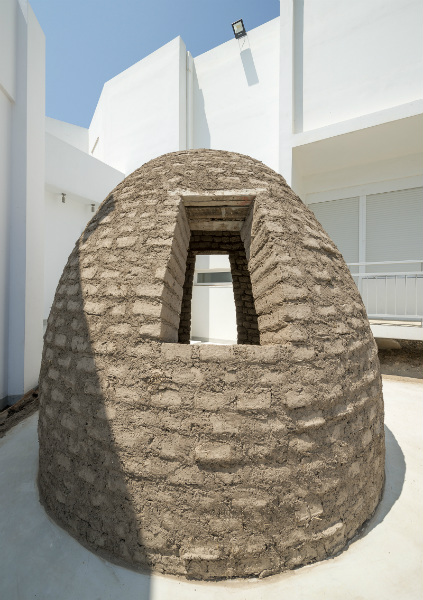
Róza El-Hassan, Adobe House (Samos) (2016). Courtesy Schwarz Foundation, photo ©Panos Kokkinias.
The film was screened in a typical open air cinema as part of the show’s public program one night after the celebrations of August 5, when the island celebrates the anniversary of the sea battle of Samos, fought during the Greek revolution of 1824, in which the Greek fleet defeated the Ottomans. The victory is commemorated with a reenactment of the battle at the port of Pythagorion, complete with historically accurate ships, canon sounds, smoke, and fireworks. It was a surreal reminder, especially in the context of the art show, of how war and the fight for autonomy are inseparable from the mythologies at the core of national identities, and the human price of that.
“A World Not Ours” is on view at Art Space Pythagorion, Samos, Greece from August 5-October 15, 2016.